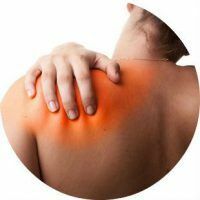
Striving for a healthy lifestyle promotes the growth of the popularity of sports clubs and gyms. However, an unusually high load or too long exercises often end in pain and body aches caused by accumulation in the muscles of lactic acid. Usually, unpleasant feelings pass independently for 1-2 days, but sometimes additional efforts are required to eliminate them.
- Education
- Symptoms
- Benefits and harm
- How to disperse
Education
The main source of energy in the body is glucose, it affects the normal functioning of the brain and the nervous system of man. During the reaction of glycolysis( cleavage of glucose), adenosine triphosphate( ATP) is formed, the amount of which determines the degree of contraction of muscle fibers and the duration of their work without fatigue. This process requires a large amount of oxygen.
Excessively high loads lead to deterioration of blood circulation, which is why oxygen supply to tissues ceases. In such conditions, in addition to the synthesis of ATP in the muscles, lactic acid( or lactate) accumulates, which, by lowering the pH level, becomes not only an indicator of quality training, but also the cause of unpleasant sensations.
Recent studies have proved the erroneousness of the idea of producing lactic acid exclusively in anaerobic( without access to oxygen) conditions - it is synthesized in muscles that receive a sufficient amount of lactic acid. An increase in its concentration with increasing intensity of loads indicates only that the organism does not have time to remove excess lactate, the production of which is significantly increased.
to contents ^Symptoms of
The main signs of lactic acid accumulation are:
- muscle pain and burning sensation, a sense of muscle failure, especially in places of greatest stress;
- general weakness and a sense of weakness - even simple movement requires considerable effort;
- increase in body temperature - up to the need to take antipyretics.
The reaction to the overload of each organism is different: some people can experience muscle pain up to several days, or even weeks. Such a state can lead not only to strength training, but also a long walk. The amount of lactic acid produced and the duration of pain sensation depends on the level of exercise and the person's preparedness.
Benefits and Harms
The formation of lactic acid hasits positive and negative sides:
- Source of energy. Lactate, accelerating the production of ATP, is considered an ideal fuel for training programs with high intensity loads. The action of another component of lactic acid - the hydrogen ion - is to slow the energy reactions and adversely affects the muscle contractions, making them weak and causing burning.
- Safety function. Accumulation of lactic acid and associated discomfort signal about the insufficient supply of oxygen to the tissues.
- Effect on muscle growth. Lactate promotes vasodilation, improved blood flow and better oxygen transport to muscle tissues.
- Discomfort directly during exercise. Lactic acid has no tendency to linger in the tissues and is excreted for several hours. However, do not overload the body - frequent( more than 2 times a month) burning in the same muscle group can lead to the disintegration of muscle fibers.
- Syndrome of delayed muscle pain. Causes of a condition in which painful sensations are manifested after a few hours or days after classes are usually damage or inflammation of the muscle tissue, which is very typical for intensified exercises. Discomfort persists until complete recovery and has no relation to lactic acid. Fatigue and cramps can also be caused by a lack of vitamins and trace elements in the body.
- Lactacidosis is a pathological increase in the volume of lactic acid, characterized by a significant increase in the acidity of the medium due to a decrease in the pH level, and is reflected in the work of almost all organs and cells. Lactacidosis does not develop from physical exertion, but is a companion of diseases such as diabetes mellitus, leukemia, sepsis, acute blood loss.
How to disperse
To neutralize the excess of lactic acid, you can use the following methods:
- Compliance with the rules of training - helps to timely neutralize the substance. Start the complex with warm-up exercises, use several approaches with short breaks between them, alternate loads of endurance and intensity, end with stretching, relaxing muscles.
- Regularity of exercises - classes on a regular basis contribute to the adaptation of the cardiovascular system to work hard and supply the necessary amount of oxygen to the tissues, and also accustom the body to a certain regime.
- Active rest - studies have shown that the level of lactic acid in the body stabilizes faster when riding a bicycle or walking than when lying on your back after training.
- Heating procedures( sauna, bath, hot bath) - under the influence of temperature, the vessels and muscle fibers expand, the movement of the blood accelerates, and the body quickly restores. Several approaches for 10 minutes of stay in hot water or steam room should be alternated with cool dousing.
- The use of anabolic formulas is a special class of sports nutrition products that are designed to improve training efficiency and achieve quick results by improving metabolism in the body.
- Liquid consumption - a plentiful drink in the form of green tea, juice, water, watermelon promotes early recovery.
